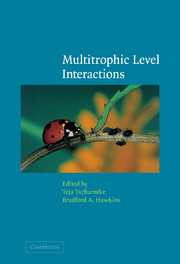Book contents
- Frontmatter
- Contents
- List of contributors
- 1 Multitrophic level interactions: an introduction
- 2 Plant genetic variation in tritrophic interactions
- 3 Multitrophic/multispecies mutualistic interactions: the role of non-mutualists in shaping and mediating mutualisms
- 4 Tritrophic interactions in tropical versus temperate communities
- 5 Endophytic fungi and interactions among host plants, herbivores, and natural enemies
- 6 Multitrophic interactions in space: metacommunity dynamics in fragmented landscapes
- 7 The chemical ecology of plant–caterpillar–parasitoid interactions
- 8 Canopy architecture and multitrophic interactions
- 9 Tritrophic below- and above-ground interactions in succession
- 10 Multitrophic interactions in decomposer food-webs
- Index
9 - Tritrophic below- and above-ground interactions in succession
Published online by Cambridge University Press: 08 August 2009
- Frontmatter
- Contents
- List of contributors
- 1 Multitrophic level interactions: an introduction
- 2 Plant genetic variation in tritrophic interactions
- 3 Multitrophic/multispecies mutualistic interactions: the role of non-mutualists in shaping and mediating mutualisms
- 4 Tritrophic interactions in tropical versus temperate communities
- 5 Endophytic fungi and interactions among host plants, herbivores, and natural enemies
- 6 Multitrophic interactions in space: metacommunity dynamics in fragmented landscapes
- 7 The chemical ecology of plant–caterpillar–parasitoid interactions
- 8 Canopy architecture and multitrophic interactions
- 9 Tritrophic below- and above-ground interactions in succession
- 10 Multitrophic interactions in decomposer food-webs
- Index
Summary
Introduction
Ecological succession is a pivotal process in ecology, since it occurs in all dynamic systems. It is therefore hardly surprising that its study is still a major preoccupation of ecologists, though as one combs the past scientific literature there are clear fashions in areas of interest and the approach adopted. Thus, from early descriptions of specific successional patterns of the vegetation, attention turned to a consideration of the mechanisms underpinning succession and ways in which successional trajectories could be modeled.
The study of succession has traditionally been dominated by plant ecologists. Even though plant–animal and, to a lesser extent, plant–microbial interactions have been in vogue for much of the time span of successional studies, relatively few workers have considered these in the context of succession. Of course, one notable exception is in the practical management of plant succession by the larger herbivores, which has also attracted scientific rigor (e.g., Gibson and Brown, 1992). Successional interactions with other less conspicuous organisms, namely invertebrates and microorganisms, have been given far lower priority by ecologists. Once these interactions become more complex, by involving other organisms or trophic levels, priority has fallen even further. In the few studies that do exist, interest has focused on the interactions that can be seen, namely those between organisms associated with above-ground plant structures. Include soil organisms and there is a gaping void in our knowledge!
- Type
- Chapter
- Information
- Multitrophic Level Interactions , pp. 197 - 222Publisher: Cambridge University PressPrint publication year: 2002
- 7
- Cited by



